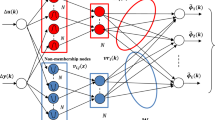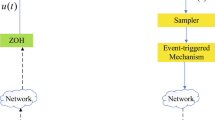Abstract
This article introduces the adaptive controller for a class of nonlinear discrete-time systems based on the sliding shuttering condition and the self adjustable network called Multi-Input Fuzzy Rules Emulated Network (MIFREN). By using only the online learning phase, MIFREN’s functional is the nonlinear discrete-tine function approximation and the disturbance estimation together. The proposed theorem is introduced for the designing procedure of all controller’s parameters and MIFREN’s adaptation gain. Simulation results demonstrate the justification of the theorem for the tracking performance and the unknown disturbance rejection.
Similar content being viewed by others
References
Chen M, Linkens DA (1998) A hybrid neuro-fuzzy PID controllers. Fuzzy Sets Syst 99:27–36
Chen L, Narendra K (2004) Identification and control of a nonlinear discrete-time system based on its linearization: a unified framework. IEEE Trans Neural Netw 15(3):663–673
Fang Y, Chow TWS, Li XD (1999) Use of a recurrent neural network in discrete sliding-mode control. IEE Proc Control Theory Appl 146(1):84–90
Furuta K (1990) Sliding mode control of a discrete system. Syst Control Lett 14:145–152
He P, Jagannathan S (2007) Reinforcement learning neural-network-based controller for nonlinear discrete-time systems with input constraints. IEEE Trans Syst Man Cybern 37(2):425–436
Jagannathan S (2006) Neural network control of nonlinear discrete-time systems. Taylor & Francis, London
Jang JS, Sun CT, Mizutani E (1997) Neuro-fuzzy and soft computing. Prentice-Hall, Englewood Cliffs
Lee CH, Teng CC (2000) Identification and control of dynamic system using recurrent fuzzy neural networks. IEEE Trans Fuzzy Syst 8:349–366
Lin CT (1996) Neural fuzzy systems. Prentice-Hall, Englewood Cliffs
Lin F-J, Fung R-F, Wai R-J (1998) Conparison of sliding-mode and fuzzy neural network control for motor-toggle servomechanism. IEEE/ASME Trans Mechatron 3(4):302–318
Misawa EA (1997) Discrete-time sliding mode control: the linear case. J Dyn Syst Meas Control 119:819–821
Rubio J, Yu W, Ferreyra A (2006) A new discrete-time sliding-mode control with neural identification. In: Proceedings of the 2006 American control conference, Minneapolis, Minnesota, USA, 14–16 Jun 2006, pp 5413–5418
Rudin W (1976) Principles of mathematical analysis. McGraw-Hill, New York
Shi Y, Mizumoto M (2001) An improvement of neuro-fuzzy learning algorithm for tuning fuzzy rules. Fuzzy Sets Syst 118:339–350
Tang CY, Misawa EA (2000) Discrete variable structure control for linear multivariable systems. J Dyn Syst Meas Control 122:783–792
Topalov A, Kaynak O (2004) Neural network modeling and control of cement mills using a variable structure systems theory based on-line learning mechanism. J Process Control 14:581–589
Treesatayapun C (2005) The knowledge-based fuzzy rules emulated network and its applications on direct adaptative nonlinear control systems. Int J Uncertain Fuzziness Knowl-based Syst 13(6):567–578
Treesatayapun C (2006) Nonlinear systems identification using multi input fuzzy rules emulated network. In: ITC-CSCC2006 international technical conference on circuits/systems, computers and communications, Chiangmai, Thailand, 10–13 July 2006
Treesatayapun C, Uatrongjit S (2005) Adaptive controller with Fuzzy rules emulated structure and its applications. Eng Appl Artif Intell 18:603–615
Treesatayapun C, Uatrongjit S (2006) Biological systems drug infusion controller using FREN with sliding bounds. IEEE Trans Biomed Eng 53(11):2405–2408
Treesatayapun C, Uatrongjit S (2006) Controlling chaos by hybrid system based on FREN and sliding mode control. J Dyn Syst Meas Control 128(2):352–358
Utkin VI (1977) Variable structure systems with sliding modes. IEEE Trans Automat Contr AC-22:212–222
Utkin VI (1993) Sliding mode control in discrete-time and difference systems. In: Zinoder AS (ed) Variable structure and Lyapunov control. Springer, Berlin, pp 83–103
Wang D, Huang J (2001) A neural-network-based approximation method for discrete-time nonlinear servomechanism problem. IEEE Trans Neural Netw 12(3):591–597
Author information
Authors and Affiliations
Corresponding author
Rights and permissions
About this article
Cite this article
Treesatayapun, C. Nonlinear discrete-time controller based on fuzzy-rule emulated network and shuttering condition. Appl Intell 31, 292–304 (2009). https://doi.org/10.1007/s10489-008-0127-x
Received:
Accepted:
Published:
Issue Date:
DOI: https://doi.org/10.1007/s10489-008-0127-x




